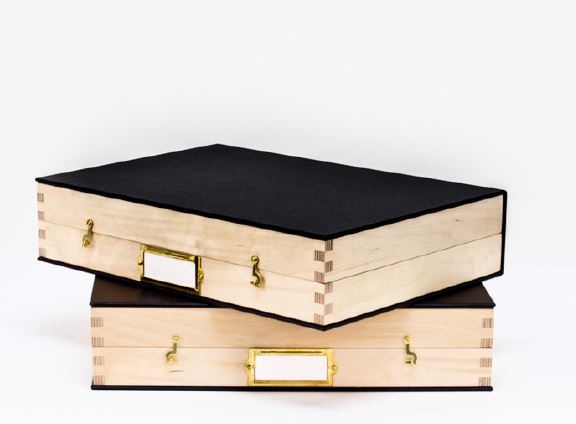Perfect Protection for Works of Art, Documents: NESCHEN gudy® 831 Perfects Solander Boxes from Down Under
Solander boxes for proper and professional archiving of works of art, photographs, documents, or books are both attractive and useful. The invention of the practical book-form cases dates back to the mid-18th century and the naturalist Daniel Solander. The boxes were perfected at City Art Depot in Christchurch, New Zealand. With NESCHEN gudy® 831 special adhesive they are not only more efficient to manufacture, but, as the adhesive has passed the Photographic Activity Test (PAT), the Solander boxes meet all the requirements of archival storage immediately on production.
The botanist Daniel Solander accompanied Captain James Cook on his first voyage to the Pacific in the mid-18th century. To ensure safe storage of his collected insects, leaves, and artifacts, Solander developed the special fold-down box that bears his name. During his time at the British Museum in London he discovered that specimens previously archived mainly in lidded boxes could easily be damaged. To study an item more closely it first had to be taken out of the box by hand. The box that Daniel Solander devised opens up in the middle like a book, providing direct access to the contents without having to handle them.
Further development of the hand-made Solander box
These boxes are still in demand and are used in New Zealand and elsewhere for long-term storage of valuable documents, unique photographs, and rare artifacts or works of art. The archiving and art experts at City Art Depot in Christchurch have further refined the Solander box. “For about 25 years we have made our Solander boxes by hand for private customers, art galleries and museums throughout New Zealand,” says City Art Depot’s David Trerise. “Our boxes are not only simple and robust archive containers but also very attractive wooden boxes that can be made to the customer’s exact specifications.”
Only sustainable materials that meet the requirements of archival storage are used in the manufacture of City Art Depot Solander boxes. David Trerise explains what that means. “The boxes must be chemically stable and inactive inside. Valuable originals such as photographs, documents or paintings might otherwise be at risk of reacting to the gases released. This can cause problems such as discoloring.” The sides of the box consist of Forest Stewardship Council-certified, multilayered birch wood. The characteristic dovetail joints at the corners are most striking. The formaldehyde emissions of the adhesive used fulfills the requirements of the California Air Resources Board (CARB). “The quality and stability of all materials are most important to us in order to provide optimum protection of whatever is stored in the box,” Trerise adds. “For the interior lining we use 100% cotton fiber museum board.”
A coincidence leads to the great step forward
The lid, back and rear of the Solander boxes from Down Under are made of especially stable polyethylene-coated aluminum. City Art Depot clads it with buckram as used in library binding. Gluing durable linen fabric to the exterior was initially difficult. “Before collaborating with NESCHEN we used liquid glue, but it had a crucial disadvantage. Off-gassing occurred as it dried, releasing harmful substances into the interior of our boxes,” Trerise says. Boxes made in this way had to be aired for a long time before shipping.
A coincidence brought about the solution in 2008. City Art Depot was looking for dry adhesives to mount photographs. In the process the archiving professionals came across gudy® 831 double-sided adhesive tissue from NESCHEN. “The material had passed the internationally recognized Photographic Activity Test (PAT) that identifies chemical reactivity which might damage photographs or other artifacts.” City Art Depot ordered gudy® 831 from NESCHEN and the NESCHEN 1600 MOVE laminator to go with it. “Shortly after setting up the laminator I realized that we could use gudy® 831 for our Solander boxes too,” Trerise says, adding: “That was a great step forward for us.”
Change in manufacture, better result
The New Zealanders have since changed and improved the way in which they manufacture their birch wood boxes. Liquid glue and drying times are history; so is off-gassing. “NESCHEN was the only firm that offered a product of this kind. We are highly satisfied with the results,” Trerise says. The Solander boxes from New Zealand also fulfill all the requirements of art insurers for proper archival storage because none of the materials used reacts with the archived material. The refinement of Solander boxes continues unabated. In the future, gudy® 832 is to be used in New Zealand.
* * *
City Art Depot specializes in conservation picture framing and the protection of works of art in storage and transportation. Founded in 1989 by David Trerise, the Christchurch, New Zealand-based firm provides services for the art market. These include the manufacture of cedar wood tensioning frames for paintings, installing and de-installing exhibitions, secure and protected storage, framing work of all kinds, special shipping systems, and hand-made Solander boxes.
NESCHEN gudy® 831 is a long-fiber paper coated on both sides with an adhesive. gudy® 831 can be used on difficult, rough substrates and is especially suitable for gluing media such as canvas and fine art paper to rigid substrates. Typical uses are, for example, the presentation of photographs and art prints in museums or art galleries. gudy® 831 uses an environmentally-friendly, water-based adhesive. The NESCHEN product fulfills conservational requirements and has passed the Photographic Activity Test (PAT) to ISO 18916 of the Rochester Institute of Technology’s Image Permanence Institute.

